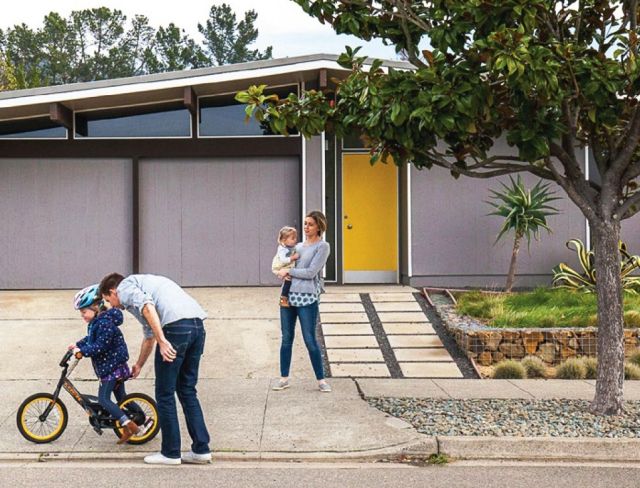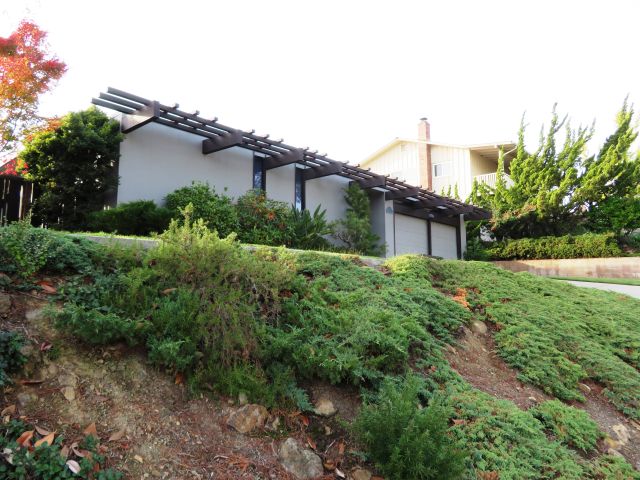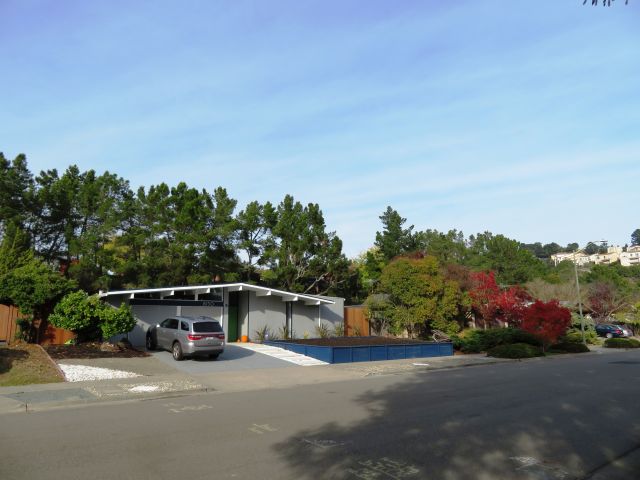
Oakland’s Eichlers Are Deemed Historic
 |
|
|
In recent years, people interested in preserving neighborhoods of homes built by Joe Eichler have been watching events unfold in the Silicon Valley cities of Palo Alto and Sunnyvale. But attention also needs to be paid to the hidden Eichlers in the Oakland Hills, where strong architectural controls work well, as revealed in ‘Harmony in the Hills,’ our story in the new spring ’18 issue of CA-Modern magazine, which goes into the mail April 15.
The 54 Eichler homes of Sequoyah Hills show remarkable architectural integrity half a century after they were built.
The homes are so intact that the 'Walk Oakland Map & Guide' identifies them as the “Eichler Houses Historic District” -- which isn’t quite accurate, though it is close.
The Eichlers of Sequoyah Hills qualify as “a potential historic district,” says Betty Marvin, who oversees Oakland’s Cultural Heritage Survey. Back in 1998 the survey determined that every one of the Eichlers there “contributed” to a potential district, which means that every house was essentially intact as seen from the street.
But the Eichlers are not an official district because no one from the neighborhood has applied.
 |
|
|
It’s a somewhat unusual sort of Eichler neighborhood because – as in such other towns as Burlingame and Foster City – the Eichlers here are part of a tract that includes more traditional homes as well.
In Sequoyah Hills, which is off Keller Avenue high above I-580, the Eichlers arre clustered around the main entry to the tract.
The president of the homeowner’s association, which includes both Eichler and Brown & Kauffmann homes, believes she knows why the Eichler owners there have maintained their looks.
“I feel it’s mostly people buying the Eichlers because they are Eichlers, and they want to keep the character of the house,” says Sandi Bethune.
The architectural guidelines that the association uses to enforce design preservation, surprisingly, do not even contain the word 'Eichler.' The guidelines apply both to the Eichlers and to the 350 or so non-Eichlers in the tract, ranch-style homes along with some Mediterranean and Monterey revivals.
Still, with few exceptions, the homes are very original from the exterior – and often in the interior.
 |
|
|
Contrast Sequoyah Hill’s design guidelines – fewer than 30 pages – with the 200-page-plus ‘Eichler Design Guidelines’ that were adopted by the Palo Alto City Council on April 2. The council decided that the guidelines would be just what that word means – voluntary guidelines, without enforcement.
In Sequoyah Hills, the design rules are enforced.
The Palo Alto council did, however, provide the opportunity for individual neighborhoods to establish ‘Eichler districts’ in which the guidelines could be enforced.
One Oakland homeowner who has done much to ensure that his Eichler retains its looks is Adrian Mello. In fact, he helped his home regain its looks.
Mello had Eichler in his blood, having grown up in Eichler’s Rancho San Miguel tract in Walnut Creek. His mother understood the Eichler ethos, having studied architecture at UC Berkeley, a hotbed of Bay modernism. Both his parents were teachers of at the California College of Arts and Crafts.
“My experience growing up in that kind of home, I thought it was completely normal,” Mello recalls.
After his parents divorced, and as he grew up and raised a family, Mello lived in a succession of houses, “a house in Sausalito, modern but not very good,” “a former senator’s mansion,” and “a beautiful Craftsman that I restored near Mill Valley.”
 |
|
|
“But when I would have dreams, the houses in my dreams, they would always be an Eichler,” he says.
Mello was working in downtown Oakland when he first heard there were Eichlers in Oakland. It is not a well known fact.
“Then I thought, maybe it’s time to buy an Eichler house, because my unconscious seems to be insisting that this is my space,” he says. He bought a double-A-frame model by architects Jones & Emmons.
The house had undergone an incompatible remodeling so Mello set to work. “I was not going for pure originality but for design integrity,” he says. He restored the ceiling, replaced some mahogany panels, and worked with a painter to achieve the proper finish.
“The Eichler had a pseudo-Victorian oval stained glass window in the front door,” he says. “I kept that until the end of the restoration, to provide the motivation to get the job done.”
And to accomplish that, Mello didn’t even need to consult design guidelines.
For more on Oakland’s Eichlers, don't miss ‘Harmony in the Hills’ a sneak preview of the new spring ’18 issue of CA-Modern magazine.
- ‹ previous
- 446 of 677
- next ›



